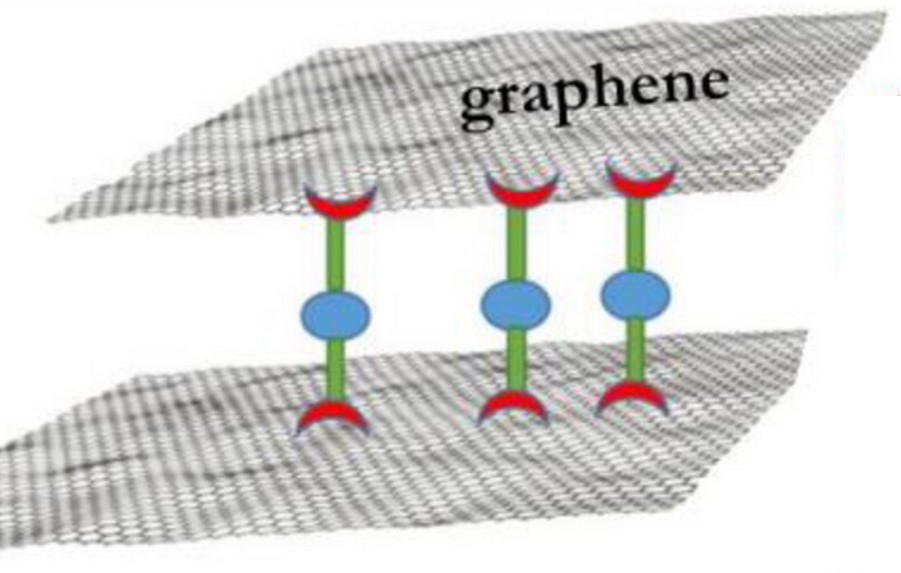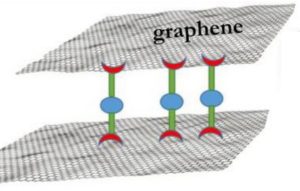Intermittent power generation and the growing use of mobile electrical devices require efficient energy storage systems, with fast charging, long life and high power density. Supercapacitors, based on the storage of charges on the surface of electrodes, are competitive candidates for applications requiring high power and electrical capacitance, together with and extended cycling stability. The active part of these components is mainly based on carbonaceous materials such as graphene, but their lifetime is affected by the agglomeration of graphene sheets during charge-discharge cycles.
A collaboration between researchers at PPSM, an ENS Paris-Saclay laboratory, and NIMBE/LEEL has improved supercapacitor performance by functionalizing reduced graphene oxide with tetrazine molecules (R-C2N4-R’), which are small electroactive aromatic compounds. By combining SEM, XRD and electrochemical measurements, this functionalization is shown to restrict the agglomeration of graphene sheets, thereby increasing the capacitance of the supercapacitor and significantly improving its performance: a 30% increase in capacitance in two-electrode cells is confirmed, with a lifetime in excess of 3,000 cycles, at a cell voltage of the order of 1 V.

Supercapacitors are high-power electrical devices that can be recharged in a few minutes thanks to the storage of ions on the surface of the electrodes, a process that is very different from the slower intercalation of these ions within an electrode in a battery. As the charges are stored on the surface, carbonaceous and nanostructured constituent materials, such as carbon nanotubes and here graphene sheets, are well suited to the process, thanks to their high specific surface area and good electrical conductivity [1]. In the case of graphene, the restacking of the sheets to form graphite reduces the component’s lifetime and efficiency [2]. It has been shown here that grafting tetrazine molecules onto reduced graphene oxide sheets steadily improves the performance of the electrodes over more than 3,000 charge-discharge cycles [3].

Functionalization of FGS13 (reduced graphene oxide with a C/O ratio close to 13)
with a tetrazine named here Tz1.
To avoid agglomeration of the graphene sheets, the idea is to add a chemical functionalization to them. This functionalization must be well controlled, to preserve the electrical properties of graphene and enable its use in supercapacitors. In this study, tetrazine molecules are chosen as a chemical graft to prevent graphene agglomeration, while they can also act as a redox active group, adding to the role of reduced graphene oxide.

SEM images showing the increase in defects and pores in functionalized graphene sheets (FGS-Tz1), confirmed by the XRD study (right) of FGS 13 and Tz1-functionalized FGS13. The appearance of a second diffraction peak at 2θ = 44 is one signature of the graphene sheet separation.
The positive effects of functionalization with tetrazine molecules are confirmed by SEM, XRD and AFM analyses. SEM micrographs reveal the presence of noticeable defects, pores and increased interlayer spacing in the functionalized samples compared with the pristine material. The grafted material shows a broadened X-ray diffraction peak around 26° compared with the virgin material, indicating a reduction in crystalline sheet size. The presence of a new peak at 2θ = 44° reflects a new structural orientation after functionalization. This is linked to the bridges created between the graphene sheets, whose spacing out results in a higher charge storage capacity.
Testing using three-electrode cyclic voltammetry is the classic way of measuring the performance of supercapacitors. However, for a cyclability evaluation compared with those of commercial devices, a test using two-electrode cells is necessary. Different current collectors were coated with functionalized graphene, with different binders, and the electrochemical performance of the assembly has been evaluated. The increases in supercapacitive storage and cycling life when using graphene grafted with tetrazine were thus confirmed in three-electrode and two-electrode cells. For the latter, the increase in capacity is 30 % compared with the ungrafted material, with a current density of up to 1 A/g. Grafted graphene also offers a promising lifespan, with over 3,000 cycles virtually without any reduction in capacity at a cell voltage of 1 V.

Evolution of the capacitance and coulombic efficiency of the functionalized reduced graphene oxide (FGS13-Tz1) at a cell voltage of 1 V (red and black) and 2.5 V (blue and violet).
The results of this collaborative research show the benefits of grafting tetrazine onto the surface of graphene sheets to increase the capacity of supercapacitors. This results in a larger specific surface area, while maintaining a good cyclability, when operating in the one volt range. Further research is required to improve performance at higher operating voltages.
The results of this collaborative research demonstrate the benefits of functionalizing the graphene structure with tetrazine, to increase its capacitance by developing a larger specific surface area, while maintaining good cyclability for operating voltages up to one volt. Further research must be pursued to improve the performance at higher operating voltages.
References:
[1] “Graphene-based materials for supercapacitor electrodes – A review”,
Q. Ke, J. Wang, J. Materiomics, 2 (2016) 37-54.
[2] “Functionalization of graphene oxide by tetrazine derivatives: a versatile approach toward covalent bridges between graphene sheets”
Y. Li, V. Alain-Rizzo, L. Galmiche, P. Audebert, F. Miomandre, G. Louarn, M. Bozlar, M. A. Pope, D. M. Dabbs and I. A. Aksay, Chem. Mater. 27(12) (2015) 4298–4310.
[3] “Functionalization and crosslinking of reduced graphene oxide sheets by multiple tetrazine units to improve the energy storage in supercapacitors“,
M. Bosmi, A. Adeniji, E. Michel, A. Brosseau, V. Brasiliense, P. Audebert, R. Pongilat, M. Gauthier and F. Miomandre, Chemelectrochem, 11 (2024) e202300467
Contact CEA-IRAMIS: Magali Gauthier and Remith Pongilat (NIMBE/LEEL UMR CEA-CNRS).
Collaboration:
- Dr. M. Bosmi, E. Michel, A. Brosseau, Dr. V. Brasiliense, Prof. P. Audebert, Prof. F. Miomandre, Université Paris-Saclay, École Normale Supérieure Paris-Saclay, CNRS, PPSM, 4 avenue des Sciences 91190 Gif-sur-Yvette, France
- A. Adeniji, Dr. R. Pongilat, Dr. M. Gauthier, Université Paris-Saclay, CEA, CNRS, NIMBE/LEEL, 91191 Gif-sur-Yvette, France




